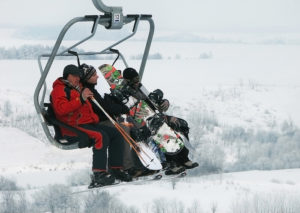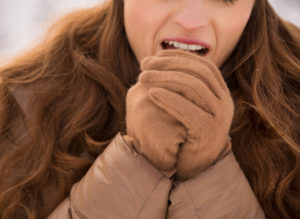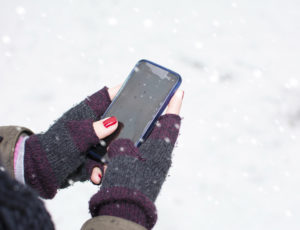Frostbite Symptoms: Exposure to the Elements Can Land You in an ER
Frostbite is no stranger to most of us. Typically, it can be managed with simple treatments, but frostbite symptoms need quick action, as our contributor—an ER doctor—describes.
On a late Sunday winter evening, I received a patient in the Emergency Department with a minor complaint of right second and third finger pain. In triage, he said his fingers were sore and also itching: frostbite symptoms.
When I got the call to triage, the patient held out his right hand to show me. I noticed he was a “ruddy-faced” man, and that he was wearing matching ski jacket and pants. He had ski gloves clipped to his jacket, and he was with a child who was also in full winter regalia. I asked him, “Which mountain did you ski today” (utilizing my full ER Doc deductive powers). He said, “We just came back from Stratton Mountain in Vermont. We went skiing for the weekend but we stopped early because it was very cold.”
He said he thinks he froze his fingers when he was taking his gloves on and off to adjust the kids’ equipment. He said he skied with gloves that were too thin—plus, he got them wet a one point. He also said he was experiencing a burning feeling in his nose and cheeks.
I quickly surveyed his hand, face, and skin. His lungs were clear, his vitals normal and his face red and rosy but with a few scattered “scarlet”-looking blotches over his upper cheeks and nose. He said he wanted treatment and advice, but didn’t want to wait long. (Some things never change!)
I led the patient back to the minor treatment area to address his frostbite symptoms. I asked an ER technician to get a large bowl of warm water and some warmed compresses to apply to the patient’s face and nose. I reassured the man and said that he had some mild frostbite. I explained to him that if we take appropriate action now, he should have no major issues.

Even when prepared for outdoor winter activities, sometimes the best-laid plan take a back seat: Gloves get lost or wet, and hands get exposed and become at risk for frostbite symptoms.
The Dangers of Frostbite Symptoms
I have seen a number of patients over the years with a similar presentation resulting from exposure during various types of activities. Whether it was skiing, biking, hiking, shoveling snow, snowboarding, or other goings-on, there is always a common path: prolonged exposure to wind, cold, low temperatures, and clothing that was inadequate.
In most of these cases, I diagnosed frostbite or frostnip, which describe localized tissue hypothermia. It is usually mild, and it usually has a good prognosis.
A recent case I wrote up described serious, life-threatening hypothermia (see “Hypothermia Symptoms: An ER Doctor’s Tale of a Patient in Dire Shape“). For this discussion, I’ll describe mild localized hypothermia to the skin, face, or an extremity. Although I’m focusing here on the frozen fingertip or nose, keep in mind that local frostbite can cause serious injury in more extreme cases.
Sizing Up Cold-Weather Danger
Within the category of mild cold injuries, we can divide the various condition into:
READY FOR WINTER?
Don’t let winter storms take you by surprise. As the weather turns, take into account the advice in this post at The Old Farmer’s Almanac: Are You Prepared for the Next Blizzard? 5 Tips for Weathering the Next Storm.
- Frostbite
- Frostnip
- Pernio (or chiblains)
- Immersion foot (also known as “trench foot“)
Frostbite can be classified into grades 1 through 4, although you’ll also see a traditional classification that treats frostbite similarly to burns: first degree, second degree, third-degree, and fourth degree.
Frostnip describes mild to minor tissue exposure to cold. It causes tingling and a “pins and needles” feeling (paresthesia) that will improve quickly with rewarming. No permanent tissue injury results.
Pernio (or chilblains) demonstrates ulcers that are reddish, purple lesions, and that can lead to pain and itching. Pernio tends to be most common in young women; however, sex and age is variable. They are treated by relieving the inciting conditions and further cold exposure and by applying ointments, creams, and protective dressings. Pernio ulcers heal over several weeks
Frostbite can be mild, moderate to severe, or classified as grades 1 through 4 in increasing severity. In most mild cases, simple rewarming and protection with a dressing or ointment is all that is necessary.
Considering Frostbite Treatment
In assessing frostbite and determining frostbite treatment, the doctor or clinician needs to rewarm the tissue before he is able to fully diagnose the degree of injury.

Frostbite symptoms typically show up in our extremities (fingers and toes) or exposed areas of skin.
It’s important not to rub or squeeze the frostbitten tissue because this can further traumatize mild injured cells. This is often counter-intuitive because limb-rubbing and friction are often perceived ways of warming exposed extremity or skin.
In mild frostbite (Grade 1), injury is superficial. The area may look pale and there may be some associated redness and slight swelling. In these cases the application of gentle warm air or warm bath emersion is quite helpful, once tissue is fully exposed. The area should be gently cleaned and periodically re-assessed during the warming process. For this type, rapid resolution will occur within 1-2 days.
In second-degree frostbite (early grade 2), one may see the formation of blisters developing within 24 hours (they’re similar to those seen in second degree burns. There may be mild tissue injury or ischemia to soft tissue of the extremities.
In third-degree frostbite, the injury (Grades 3 and 4) is even deeper into the tissue layers, and the blisters tend to be smaller but are associated with bruising and bleeding under the skin. As such, discoloration and scab formation are more common.
Bone amputation is likely in these grades if a digit or small extremity is involved. At this level a surgeon or plastic surgeon and hospital admission is appropriate. There needs to be ongoing wound care in the form of dressing changes and extensive tissue treatment and evaluation. In many cases this severe, a number of minor surgical procedures may be required to remove dead or dying tissue and prevent secondary infection and to control pain and disfigurement.
For the purposes of this discussion I want to stress to the readers that most of you will be dealing with only the most mild exposures (luckily enough) and some very simple rules can help reduce the risk of more serious or advanced frostbite.
The Importance of Being Prepared
In cold weather we can quickly experience frostbite if we are not properly protected and informed as to the risk or changing weather conditions. So, check the weather report. Subzero weather with a wind-chill should be a “red flag” for the donning of warm hats and gloves. If the wind will be persistent (such as in skiing) facial and skin balms that form a protective layer on the skin should be used, in addition to hat, gloves and warm socks. In some scenarios it may be recommended to wear neoprene facial, neck or extremity protection. Any of these wardrobe variations can be readily addressed at your local sporting store, ski shop or camp store.
In the case an exposure the first step is to get out of the cold and then remove cold or wet clothing. After this initial action, rapid re-warming (without flame or direct heat) should be undertaken. A warm bath or shower is very beneficial, as is a properly adjusted hot tub.
Keep in mind that frostbitten tissue may be numb and, therefore, may be susceptible to a thermal burn that is not being felt by the patient, if fire or hot-heat is used to warm the extremity.
Finally, if symptoms readily resolve, a simple dressing of skin salve, ointment (antibiotic ointment, diaper rash ointment, or Vaseline) with a soft sterile gauze dressing is sufficient for full resolution of symptoms over 12-24 hours.
If symptoms persist after the first day, one should follow up with the local Emergency Department or their primary physician for further evaluation, treatment, and possible specialty referral.
If these simple concepts are understood, we can be warm and stay warm and more fully enjoy the benefits in being active in our winters.
HOW TO AVOID FROSTBITE

Do you put nonstop use of your cellphone ahead of sensible protection in the outdoors? (Photo: Saletomic | Dreamstime.com)
Accuweather.com offers these tips on how to protect yourself from frostbite:
- Avoid being in the cold for extended periods of time
- Be aware of the wind chill
- Wear appropriate layers
- Drink warm fluids, but avoid caffeine and alcohol
- Stay active to maintain body heat
- Take frequent breaks from the cold
Various experts also advise that you pay attention to headwear; use a hat (preferably of heavy wool and/or windproof) or a headband that fully covers your ears. Mittens are preferable to gloves; they allow your fingers to draw heat from each other. And your socks and sock liners should fit well and provide insulation; brands that “wick moisture” are preferred—wet feet will get colder more quickly.
See also these posts:



 Vestibular Migraine Diet
Vestibular Migraine Diet  Bone Spurs on the Spine
Bone Spurs on the Spine  Knee Injections for Osteoarthritis Pain Relief
Knee Injections for Osteoarthritis Pain Relief 
Plan ahead for your winter outings and avoid frostbite symptoms.
© Denis Pepin | Dreamstime.com